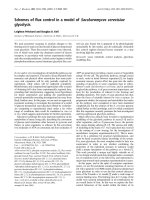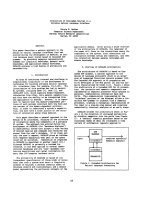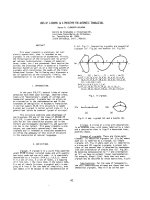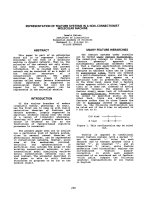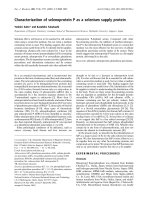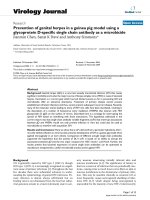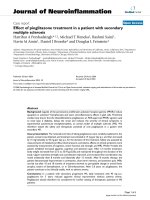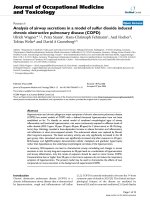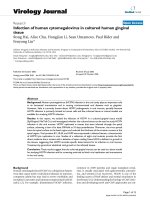Báo cáo toán học: " Immobilization of anode-attached microbes in a microbial fuel cell" docx
Bạn đang xem bản rút gọn của tài liệu. Xem và tải ngay bản đầy đủ của tài liệu tại đây (210.68 KB, 18 trang )
This Provisional PDF corresponds to the article as it appeared upon acceptance. Fully formatted
PDF and full text (HTML) versions will be made available soon.
Immobilization of anode-attached microbes in a microbial fuel cell
AMB Express 2012, 2:2 doi:10.1186/2191-0855-2-2
Rachel C Wagner ()
Sikandar Porter-Gill ()
Bruce E Logan ()
ISSN 2191-0855
Article type Original
Submission date 13 December 2011
Acceptance date 3 January 2012
Publication date 3 January 2012
Article URL />This peer-reviewed article was published immediately upon acceptance. It can be downloaded,
printed and distributed freely for any purposes (see copyright notice below).
Articles in AMB Express are listed in PubMed and archived at PubMed Central.
For information about publishing your research in AMB Express go to
/>For information about other SpringerOpen publications go to
AMB Express
© 2012 Wagner et al. ; licensee Springer.
This is an open access article distributed under the terms of the Creative Commons Attribution License ( />which permits unrestricted use, distribution, and reproduction in any medium, provided the original work is properly cited.
1
Date: December 23, 2011
Submitted to: AMB Express
Immobilization of anode-attached microbes in a
microbial fuel cell
Rachel C. Wagner, Sikandar Porter-Gill, Bruce E. Logan*
Department of Civil and Environmental Engineering, 212 Sackett Building,
The Pennsylvania State University, University Park, PA 16802, USA
*Corresponding Author: phone: +1-814-863-7908
RW:
SP:
BL:
Keywords: microbial fuel cell, microbial electrolysis cell, bioelectrochemical system,
immobilization layer, anode, latex
2
Abstract
Current-generating (exoelectrogenic) bacteria in bioelectrochemical systems (BESs) may
not be culturable using standard in vitro agar-plating techniques, making isolation of new
microbes a challenge. More in vivo like conditions are needed where bacteria can be
grown and directly isolated on an electrode. While colonies can be developed from single
cells on an electrode, the cells must be immobilized after being placed on the surface.
Here we present a proof-of-concept immobilization approach that allows exoelectrogenic
activity of cells on an electrode based on applying a layer of latex to hold bacteria on
surfaces. The effectiveness of this procedure to immobilize particles was first
demonstrated using fluorescent microspheres as bacterial analogs. The latex coating was
then shown to not substantially affect the exoelectrogenic activity of well-developed
anode biofilms in two different systems. A single layer of airbrushed coating did not
reduce the voltage produced by a biofilm in a microbial fuel cell (MFC), and more easily
applied dip-and-blot coating reduced voltage by only 11% in a microbial electrolysis cell
(MEC). This latex immobilization procedure will enable future testing of single cells for
exoelectrogenic activity on electrodes in BESs.
Introduction
Bioelectrochemical systems (BESs) are based on electron transfer between microbes and
an electrode surface. Most investigations into the mechanisms of electron transfer from a
microbe to an anode have focused on two microorganisms, Geobacter sulfurreducens
(Marsili et al. 2008; Holmes et al. 2006; Strycharz et al. 2010; Inoue et al. 2010; Nevin et
al. 2009; Srikanth et al. 2008) and Shewanella oneidensis (Bretschger et al. 2007; Gorby
3
et al. 2006), where it has been shown that specific genes and proteins are involved in
exogenous electron transfer. Further study of current-generating (exoelectrogenic)
bacteria and biofilms will benefit from isolating and identifying other microorganisms
that are capable of electron transfer to an electrode.
Isolation techniques to identify novel exoelectrogens have typically involved
dilution-to-extinction in BESs, or isolation on ferric iron agar plates. A U-tube reactor
was developed (Zuo et al. 2008) that would allow a single microbe, obtained by serial
dilutions, to deposit by sedimentation onto a flat anode surface. This technique was used
to identify novel exoelectrogens Ochrobactrum anthropi YZ-1 (Zuo et al. 2008) and
Enterobacter cloacae FR (Rezaei et al. 2009). However, the cumbersome process
required many serial transfers to obtain these isolates. A microbe related to Clostridium
butyricum was isolated from a microbial fuel cell (MFC) using ferric iron agar plates
(Park et al. 2001), but this method of isolation does not target all exoelectrogens as some
microbes have been isolated that can generate current but not reduce iron (Kim et al.
2004; Zuo et al. 2008).
In addition to spread-plating techniques, screening of arrays of microorganisms
on ferric iron agar plates is possible through printer technology (Ringeisen et al. 2009).
This approach can be used to print very small droplets of a cell suspension diluted to
contain single microbes. To take advantage of this technology, for example by printing
single cells in a grid pattern onto an electrode for isolation, a robust immobilization layer
is required to bind the cells to the electrode so that they do not move after application to
the electrode surface. This layer should not interfere with the ability of microbes to
transfer electrons to an electrode surface, or with the diffusion of substrate to the cells.
4
Latex films were evaluated here to see if they could be used to fulfill these requirements.
Latex films have previously been used to entrap microbes on non-conducting surfaces,
producing a high density of organisms in a thin film that survived freezing and drying
(Gosse et al. 2007; Lyngberg et al. 1999; Flickinger et al. 2007). We show here effective
entrapment of bacteria-sized particles using fluorescent microspheres, and demonstrate
that latex entrapped anode biofilms allow exoelectrogenic activity.
Materials and Methods
Latex was applied to two different types of anodes, carbon paper (without wet proofing;
E-Tek) or graphite blocks (Grade GM-10; GraphiteStore.com Inc.), in two different types
of BESs in order to evaluate the immobilization method under different conditions.
Carbon paper was used as the anode in a single-chamber 28-mL microbial fuel cell
(MFC) reactor with a platinum-catalyzed air cathode (Cheng et al. 2006; Liu and Logan
2004) (both electrodes with projected surface area of 7 cm
2
). Graphite blocks (projected
surface area of 4.6 cm
2
) were used as anodes for a single-chamber 5-mL microbial
electrolysis cells (MECs) with a 1.0 × 1.5 cm
2
304 stainless steel 90 × 90 mesh cathode
(Call and Logan 2011). Carbon paper (projected surface area of 3.0 cm
2
) was also used as
anode material in some 5-mL MECs. All reactors were inoculated using cell suspensions
from pre-acclimated MFCs that were originally inoculated with domestic wastewater and
acetate. A multimeter (2700, Keithley Instruments, Inc.) was used to monitor the voltage
across an external resistor (R
ex
= 10 Ω, MEC; 1000 Ω, MFC). A power source (3645A,
Circuit Specialists, Inc.) was connected to the MEC circuit to add –0.7 V to the cathode.
All BESs were maintained at 30
o
C.
5
MFC medium was 100 mM phosphate buffer with 17 mM acetate as the substrate
(per L: 0.62 g NH
4
Cl, 4.9 g NaH
2
PO
4
●
H
2
O, 9.15 g Na
2
HPO
4
, 0.26 g KCl, 1.4 g sodium
acetate, and Wolfe’s vitamins and minerals) (Lovley and Phillips 1988). MEC medium
was 30-mM bicarbonate buffer with 10-mM acetate as the substrate, based on the ATCC
recipe for G. sulfurreducens, #1957 (per L: 1.5 g NH
4
Cl, 0.6 g NaH
2
PO
4
, 0.1 g KCl, 2.5 g
NaHCO
3
, 0.82 g sodium acetate, and Wolfe’s vitamins and minerals), without the
addition of the electron acceptor. MFC and MEC reactors were operated in fed-batch
mode until they successively produced at least 3 equivalent batch cycles, indicating a
well-established anodic biofilm.
A monodisperse latex emulsion (SF-091; Rohm & Haas) was amended with 5%
glycerol to optimize the degree of coalescence and subsequent diffusivity of the film to
the substrate (Lyngberg et al. 2001; Gosse et al. 2007). This solution was applied in two
different ways to well-established biofilms in the different BESs by removing the anodes
temporarily from the reactors. Glycerol-amended latex (referred to simply as “latex”) was
applied to the carbon paper biofilm from the MFC using an air brush (Paache, BearAir, S.
Easton, MA; 4.5 L/min of airflow). One, three, or five layers were applied, allowing 15
minutes between each layer, and one hour after the final layer, for drying at room
temperature. For the graphite blocks and carbon paper anodes from the MEC a simpler
application procedure was used, where the latex was applied by dipping the blocks or
paper into the latex, and excess solution was drawn off the anode with a laboratory wipe.
In other experiments, the glycerol-amended latex was diluted in water to 30% to see if
performance improved with a thinner layer of latex.
6
The effectiveness of the latex to immobilize bacteria on the anode materials was
examined using several different techniques. Direct observation of individual bacteria on
an electrode, when bacteria were stained using acridine orange, was not possible due to
high levels of background fluorescence. Therefore, application of individual microbes on
an electrode was simulated by applying droplets of fluorescent microspheres
(Fluoresbrite spheres, 4.1-µm diameter, Invitrogen) to graphite electrodes. Latex was
applied by the dipping method described above. After drying, the latex-coated electrode
was immersed in MFC media to simulate the electrode in a BES. The droplets were
observed with fluorescence microscopy before and after latex application and MFC
simulation.
For SEM visualization, small sections of carbon paper anodes with
exoelectrogenic biofilms with and without latex coating were mounted in cryo-matrix and
frozen. Thin slices were removed from the cross-section with a microtome until a smooth
surface was obtained. The surface was etched with the cryo-SEM electron beam to
remove ice crystals before viewing.
Results
Latex preparation. Application of glycerol-amended latex with the airbrush resulted in
~2.1 mg dry weight of latex per cm
2
anode area per layer. Application by dipping and
blotting of the glycerol-amended latex onto graphite block resulted in ~5.3 mg/cm
2
/layer
for 100% latex-glycerol, and 0.67 mg/cm
2
/layer for 30% latex-glycerol. On carbon paper,
~8.1 mg/cm
2
/layer was applied for 100% latex-glycerol, and 2.5 mg/cm
2
/layer for 30%
latex-glycerol.
7
Immobilization of microspheres and microbes. Fluorescent microspheres are often used
as analogs for microorganisms (Smith and McKay 2005; Solomon and Matthews 2005).
The location and shape of a droplet of microspheres (4.1-µm diameter) on an electrode
were retained after latex application and drying, and after submersion in standard MFC
media.
The latex film applied with an airbrush to an exoelectrogenic biofilm on a carbon
paper anode remained completely intact, without dissolving or cracking, after 6 cycles in
an MFC (Figure 1). The layers of latex coalesced into one continuous overlay. The
biofilm was not visible in SEM images due to preparation requirements for the latex;
however, the presence of the biofilm was confirmed by the exoelectrogenic activity
through current production in the MFC. The latex layer applied to the MEC carbon paper
anode using the dip-and-blot method also remained visibly intact throughout the
experiment. The latex layer applied to the graphite block with the dip-and-blot method
had variable performance. The layer made using the 30% dilution remained intact.
However, at full strength, the latex layer did not consistently remain adhered to the block,
and in some reactors, the latex began to peel off after ten days.
Latex coatings on anode biofilms. When one layer of glycerol-amended latex was applied
with the airbrush to a biofilm on carbon paper in an MFC, the reactor recovered
immediately to its pre-latex voltage. When three layers were applied, the reactor returned
to its original performance in 6 cycles. However, when five layers were applied, the MFC
only reached 45% of its original voltage even after 6 cycles (Figure 2).
8
Using undiluted glycerol-amended latex for immobilization of microbes on a
graphite block, the MEC with graphite block anode returned to 42% (±8%) of its original
current within three cycles of latex application by dipping and blotting. However, after
three cycles, which took approximately 10 days, the overlay had started to delaminate
from the graphite block, so testing was discontinued. Using a 30% dilution of the latex-
glycerol, the current recovery in the MECs improved, reaching 85% (±9%) of the original
current within 3 cycles of latex application with consistent results over 3 additional
cycles (Figure 3). In addition, the latex remained adhered to the anode.
When the undiluted overlay was applied to carbon paper anodes in the MECs,
current returned to 43% of the original level within 3 cycles and was maintained in
further batches. With the thinner, 30% diluted layer, current returned to 89% (±6%) of
the original current within 3 cycles of application and remained consistent in subsequent
batches (Figure 4).
Discussion
Latex films were shown be effective in holding individual particles (fluorescent
microspheres) or active biofilms on electrically conductive surfaces. Microbes trapped on
two different surfaces (carbon paper and graphite block) using different application
methods (airbrushing and dip-and-blot) retained most of their exoelectrogenic capability.
On both surfaces, and in both MFC and MEC reactors, increasing the amount of latex
applied onto the biofilm adversely affected the ability of the anode to recover
exoelectrogenic activity to pre-application current levels. Lyngberg et al. (2001) found
that effective diffusivity through the latex was highly dependent on layer thickness.
9
Therefore, this decrease in activity was likely due to a reduction in mass transfer to
(substrate) and from (protons) the biofilm with thicker layers of latex.
The latex coating thickness, measured by dry weight, on the graphite block was
less than that of the graphite paper, and the full strength latex coating did not stick well to
the block. The coating on the carbon paper when applied by the air brush to the MFC
anode or the dip-and-blot method (at 30% strength) to the MEC anode was similar
(slightly more than 2 mg/cm
2
/layer). While the MFC regained 100% of its pre-application
performance, the MEC was limited to about 89% of its pre-application performance. It is
unlikely that there was any decrease in the performance of the MEC in these experiments
due to exposure of the biofilm to oxygen during the latex application, as MEC biofilms
are routinely exposed to air when it they are refilled (often intentionally to reduce
methanogenesis) without adverse affects to current production (Call and Logan 2008). In
addition, the biofilm in an MFC is routinely exposed to oxygen in air due to oxygen
diffusion through the cathode and into the anode chamber without apparent adverse
effects. If desired, the latex film could be applied under strictly anoxic conditions in an
anaerobic glove box. Previous work with bio-catalytic films used for hydrogen gas
production has shown that the coating itself is not adversely affected by the presence or
absence of air, nor is the performance of that biofilm (Gosse et al. 2007). However, it is
possible that some strict anaerobes might be affected by oxygen during this procedure, so
anaerobic application of the latex biofilm may be of interest in future studies.
The ability to immobilize microbes on an electrode using a latex film has two
valuable applications for BESs, but for successful application in BESs, immobilization of
microbes on electrodes must not interfere with the ability of cells to transfer electrons.
10
Bioelectrochemical features seen in cyclic voltammograms of pectin-entrapped
Geobacter biofilms have been shown to be similar to naturally-grown Geobacter biofilms
(Srikanth et al. 2007). This suggests that entrapment by itself is not changing the
electrical capability of the cells, although they found current was somewhat decreased as
observed here as well. One application of an immobilization layer for cells on a BES
electrode is isolation of microbes directly on an electrode. This requires immobilization
of an array of single cells, without greatly compromising current generation, which our
latex overlay achieves. In addition, a biofilm of specific microbes can be developed on an
electrode in a controlled setting, immobilized and protected under a latex coating, and
then introduced to a more complex, non-sterile environment. Under the coating, these
organisms would not have to compete with other microbes for the electron-accepting
surface. Exoelectrogenic biofilm activity under a glycerol-amended latex film can be
restored to nearly the same levels as pre-application activity, making it a suitable
immobilization layer for these applications.
Competing Interests
The authors declare that they have no competing interests.
Acknowledgements
This material is based upon work supported under National Science Foundation Graduate
Research Fellowships (RCW), and award KUS-I1-003-13 by King Abdullah University
of Science and Technology (KAUST).
11
References:
Bretschger O, Obraztsova A, Sturm CA, Chang IS, Gorby YA, Reed SB, Culley DE,
Reardon CL, Barua S, Romine MF, Zhou J, Beliaev AS, Bouhenni R,
Saffarini D, Mansfeld F, Kim B-H, Fredrickson JK, Nealson KH (2007)
Current production and metal oxide reduction by Shewanella oneidensis MR-
1 wild type and mutants. Appl Environ Microbiol 73 (21):7003-7012.
doi:10.1128/aem.01087-07
Call DF, Logan BE (2011) A method for high throughput bioelectrochemical research
based on small scale microbial electrolysis cells. Biosens Bioelectron 26
(11):4526-4531
Call D, Logan BE (2008) Hydrogen production in a single chamber microbial
electrolysis cell (MEC) lacking a membrane. Environ Sci Technol 42
(9):3401-3406
Cheng S, Liu H, Logan BE (2006) Increased performance of single-chamber
microbial fuel cells using an improved cathode structure. Electrochemistry
Communications 8:489-494
Flickinger MC, Schottel JL, Bond DR, Aksan A, Scriven LE (2007) Painting and
printing living bacteria: engineering nanoporous biocatalytic coatings to
preserve microbial viability and intensify reactivity. Biotechnol Prog 23 (1):2-
17
Gorby YA, Yanina S, McLean JS, Rosso KM, Moyles D, Dohnalkova A, Beveridge
TJ, Chang IS, Kim BH, Kim KS, Culley DE, Reed SB, Romine MF, Saffarini
DA, Hill EA, Shi L, Elias DA, Kennedy DW, Pinchuk G, Watanabe K, Ishii
S, Logan BE, Nealson KA, Fredrickson JK (2006) Electrically conductive
bacterial nanowires produced by Shewanella oneidensis strain MR-1 and other
microorganisms. Proc Natl Acad Sci 103 (30):11358-11363
Gosse JL, Engel BJ, Rey FE, Harwood CS, Scriven LE, Flickinger MC (2007)
Hydrogen production by photoreactive nanoporous latex coatings of
nongrowing Rhodopseudomonas palustris CGA009. Biotechnol Prog 23
(1):124-130
Kim BH, Park HS, Kim Kj, Kim GT, Chang IS, Lee J, Phung NT (2004) Enrichment
of microbial community generating electricity using a fuel-cell-type
electrochemical cell. Appl Microbiol Biotechnol 63 (6):672-681
Liu H, Logan BE (2004) Electricity generation using an air-cathode single chamber
microbial fuel cell in the presence and absence of a proton exchange
membrane. Environ Sci Technol 38 (14):4040-4046
Lovley DR, Phillips EJP (1988) Novel Mode of Microbial Energy Metabolism:
Organic Carbon Oxidation Coupled to Dissimilatory Reduction of Iron or
Manganese. Appl Environ Microbiol 54 (6):1472-1480
Lyngberg OK, Ng CP, Thiagarajan V, Scriven LE, Flickinger MC (2001)
Engineering the microstructure and permeability of thin multilayer latex
biocatalytic coatings containing E. coli. Biotechnol Prog 17 (6):1169-1179
Lyngberg OK, Thiagarajan V, Stemke DJ, Schottel JL, Scriven LE, Flickinger MC
(1999) A patch coating method for preparing biocatalytic films of Escherichia
coli. Biotechnol Bioeng 62 (1):44-55
12
Park HS, Kim BH, Kim HS, Kim HJ, Kim GT, Kim M, Chang IS, Park YK, Chang
HI (2001) A novel electrochemically active and Fe(III)-reducing bacterium
phylogenetically related to Clostridium butyricum isolated from a microbial
fuel cell. Anaerobe 7 (6):297-306
Rezaei F, Xing D, Wagner RC, Regan JM, Richard TL, Logan BE (2009)
Simultaneous cellulose degradation and electricity production by
Enterobacter cloacae in an MFC. Appl Environ Microbiol 75 (11):3673-3678
Ringeisen BR, Lizewski SE, Fitzgerald LA, Biffinger JC, Knight CL, Crookes-
Goodson WJ, Wu PK (2009) Single cell isolation of bacteria from microbial
fuel cells and Potomac River sediment. Electroanalysis 22 (7-8):875-882
Smith HD, McKay CP (2005) Drilling in ancient permafrost on Mars for evidence of
a second genesis of life. Planetary and Space Science 53 (12):1302-1308
Solomon EB, Matthews KR (2005) Use of fluorescent microspheres as a tool to
investigate bacterial interactions with growing plants. J Food Prot 68 (4):870-
873
Srikanth S, Marsili E, Flickinger MC, Bond DR (2007) Electrochemical
characterization of Geobacter sulfurreducens cells immobilized on graphite
paper electrodes. Biotechnol Bioeng 99 (5):1065-1073
Zuo Y, Xing D, Regan JM, Logan BE (2008) Isolation of the exoelectrogenic
bacterium Ochrobactrum anthropi YZ-1 by using a U-tube microbial fuel cell.
Appl Environ Microbiol 74 (10):3130-3137. doi:10.1128/aem.02732-07
1
13
List of Figures 1
2
Fig. 1 SEM image of 3 layers of latex (“latex overlay”; approximately 165 µm thick) on a 3
carbon paper anode with exoelectrogenic biofilm after 6 cycles in an MFC. The biofilm is not 4
visible due to SEM preparation techniques necessary to maintain the latex layer. 5
6
Fig. 2 An exoelectrogenic biofilm on a carbon paper anode in an MFC with 1, 3, or 5 layers 7
of latex applied to a carbon paper anode using an airbrush, compared to a reactor with no 8
latex (dashed line). Representative reactors are shown. 9
10
Fig. 3 An exoelectrogenic biofilm on a graphite block anode in an MEC immobilized with 11
glycerol-amended latex diluted to 30% strength, compared to the biofilm with no overlay 12
(dashed line). 13
14
Fig. 4 An exoelectrogenic biofilm on a carbon paper anode in an MEC immobilized with 15
glycerol-amended latex diluted to 30% strength, compared to the biofilm with no overlay 16
(dashed line). 17
Figure 1
Figure 2
Figure 3
Figure 4
